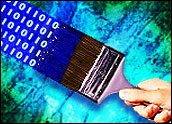
For companies burdened with legacy systems they can’t seem to get rid of, this could be the jackpot they’ve been waiting for.
A Los Gatos, California, startup maintains it has perfected a program that allows software applications compiled for one processor and operating system to run on another processor and operating system without any source code or binary changes.
While this kind of emulation isn’t new, what is new is that Transitive Corp. says its software, called QuickTransit, can perform the complicated task with a slight impact on computational performance, no impact on graphic and interactive performance and preservation of all an original application’s functionality.
Modern Alchemy
“Other solutions used in the past haven’t been able to achieve close to these levels of performance or complete functionality,” Transitive CEO Bob Wiederhold told TechNewsWorld.
According to Jim Turley, principal analyst at Silicon Insider in Pacific Grove, California, failure has been the norm in the history of emulation. “It’s one of those things that everyone tries and virtually everybody fails,” he told TechNewsWorld. “It’s a bit like modern alchemy, trying to turn base metals into gold.”
At the core of Transitive’s breakthrough technology is its method for emulating native code.
“Emulators typically translate one instruction at a time,” Wiederhold explained. “As a result, they don’t do any kind of optimization.”
“What we do,” he continued, “is take blocks of instructions, convert it into an intermediate representation and then we do all kinds of very complex optimizations across large blocks of code.”
“If they can achieve the level of performance that they’re claiming — which is 80 percent of native performance when they are emulating one architecture on another — that will allow customers who have software written for one machine to move to different systems and still use their existing software,” explained Nathan Brookwood, principal analyst at Insight 64 in Saratoga, California.
Far-Reaching Impact
“That’s just incredible,” he told TechNewsWorld. “That hasn’t been something that people could do in the history of the computer industry.”
That could have far-reaching consequences for the computer industry, he contended, especially the segment that has used the inability to move software between systems as a way to lock customers into a particular hardware line.
“It means that the proprietary locks that suppliers have had on users would be shattered, and the whole economics of the computer industry could change,” Brookwood said.
Aside from entrapment by vendors, there are other reasons companies looking to move legacy software, without recompiling it, to newer hardware will welcome QuickTransit, according to Tony Iams, lead analyst with D.H. Brown Associates in Port Chester, New York.
“Whenever you have to migrate, recompiling software is often a challenge,” he told TechNewsWorld. “If it’s a home-grown application, you might not have the source code anymore, or the people that wrote the application might be gone.”
“If it’s a third-party application,” he continued, “you might not be able to get support for it anymore.”
May Reach Desktop
The initial versions of QuickTransit will be for the Itanium processor with support for MIPS, PowerPC, x86 and mainframe binaries; the Opteron processor with support for MIPS, PowerPC and mainframe binaries; x86 processors with support for MIPS, PowerPC and mainframe binaries; and the PowerPC processor with support for MIPS, x86 and mainframe binaries.
“It won’t translate any computer to any other computer — that would be fantasy,” Silicon Insider’s Jim Turley said. “But for the computers that it supports, it works pretty darn well.”
Although Transitive is setting its sights on the enterprise market for QuickTransit, the software might be signaling a trend for cross-platform computing that will reach the desktop.
“In 2006, we could be seeing Windows running on Power,” Rob Enderle, principal analyst of the Enderle Group, told TechNewsWorld. “And we can see the Mac on Windows — either authorized or not — because the capability will exist in the second half of next year to make that happen.”
“We’re going to be talking about this a lot in 2005,” he continued. “And as we get toward the end of the decade, we’re going to be seeing some choices that we’ve never had before.”




















































